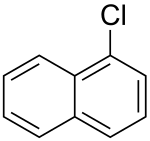1-Chloronaphthalene
1-Chloronaphthalene is an aromatic compound. It is a colorless, oily liquid which may be used to determine the refractive index of crystals by immersion.[1] The compound is an isomer to 2-chloronaphthalene.
 | |
| Names | |
|---|---|
| IUPAC name
1-Chloronaphthalene | |
| Identifiers | |
CAS Number |
|
3D model (JSmol) |
|
| ChEMBL | |
| ChemSpider | |
| ECHA InfoCard | 100.001.789 |
PubChem CID |
|
| UNII | |
CompTox Dashboard (EPA) |
|
InChI
| |
SMILES
| |
| Properties | |
Chemical formula |
C10H7Cl |
| Molar mass | 162.62 g·mol−1 |
| Melting point | −20 °C (−4 °F; 253 K) |
| Boiling point | 263 °C (505 °F; 536 K) |
| Hazards | |
| Safety data sheet | Oxford MSDS |
| GHS pictograms |   |
| GHS Signal word | Warning |
GHS hazard statements |
H302, H410 |
GHS precautionary statements |
P273 |
| Flash point | 121 °C (250 °F; 394 K) |
Except where otherwise noted, data are given for materials in their standard state (at 25 °C [77 °F], 100 kPa). | |
| Infobox references | |
Synthesis
1-Chloronaphthalene is obtained directly by chlorination of naphthalene, with the formation of more highly substituted derivatives such as dichloro- and trichloronaphthalenes in addition to the two monochlorinated isomeric compounds: 1-chloronaphthalene and 2-chloronaphthalene.[2]
Applications
This toxic, nonpolar organochlorine compound is sometimes used as a powerful biocide, and is also known as Basileum. It occasionally serves as insecticide and fungicide in the timber floors of shipping containers, where it fulfills the same role as chlordane.
1-Chloronaphthalene was also used as a common solvent[3] for oils, fats and DDT until the 1970s. It is also used to determine the refractive index of crystals.
See also
- 1-Fluoronaphthalene
- 1-Bromonaphthalene
References
- Oxford MSDS
- Bavendamm, W.; Bellmann, H. (1953). "Chlornaphthalin-Präparate". Holz als Roh- und Werkstoff (in German). 11: 81–84. doi:10.1007/BF02605462.
- "1-Chloronaphthalene". Sigma Aldrich. sigmaaldrich.com. Retrieved 14 June 2017.